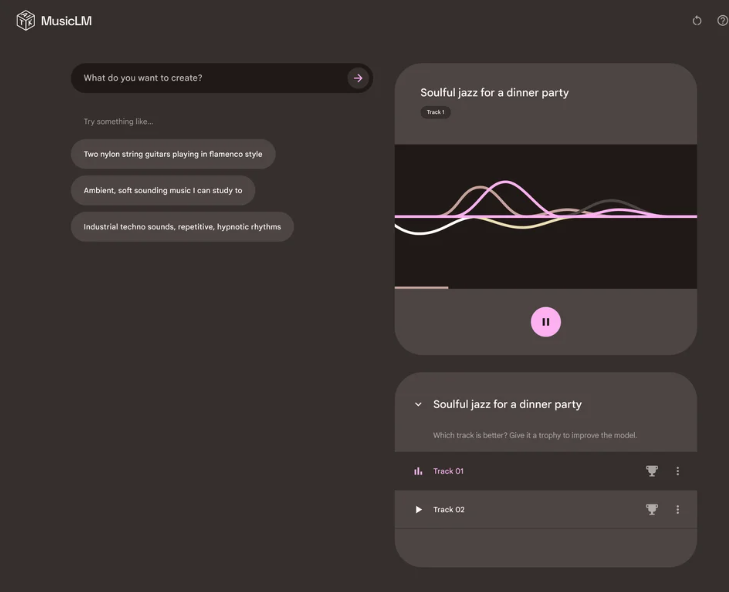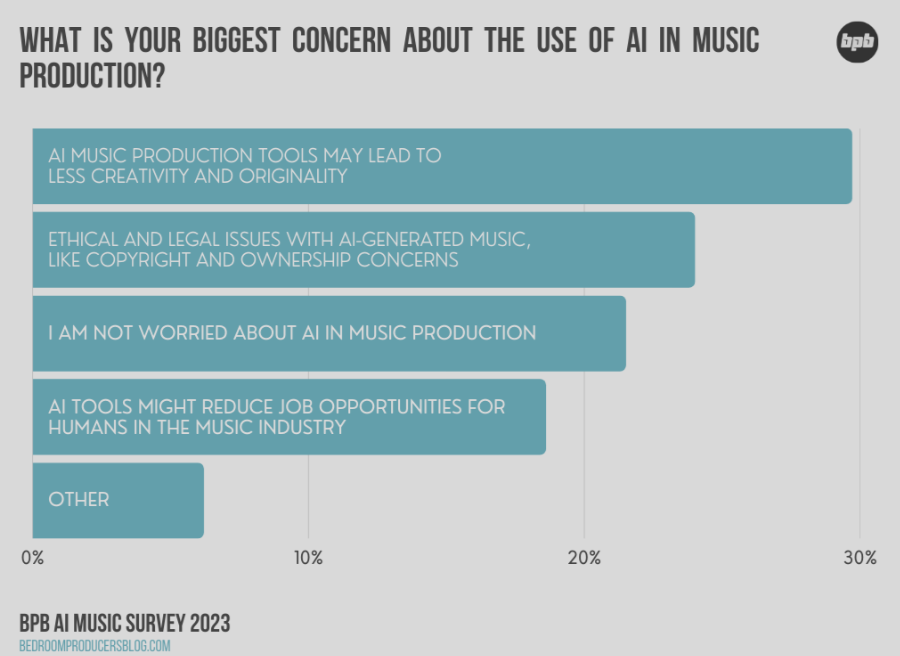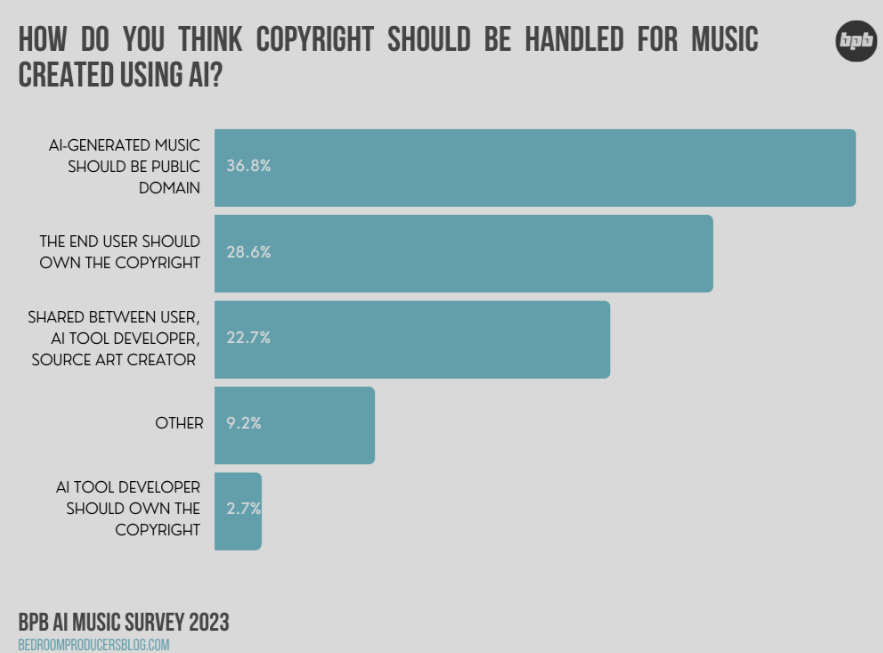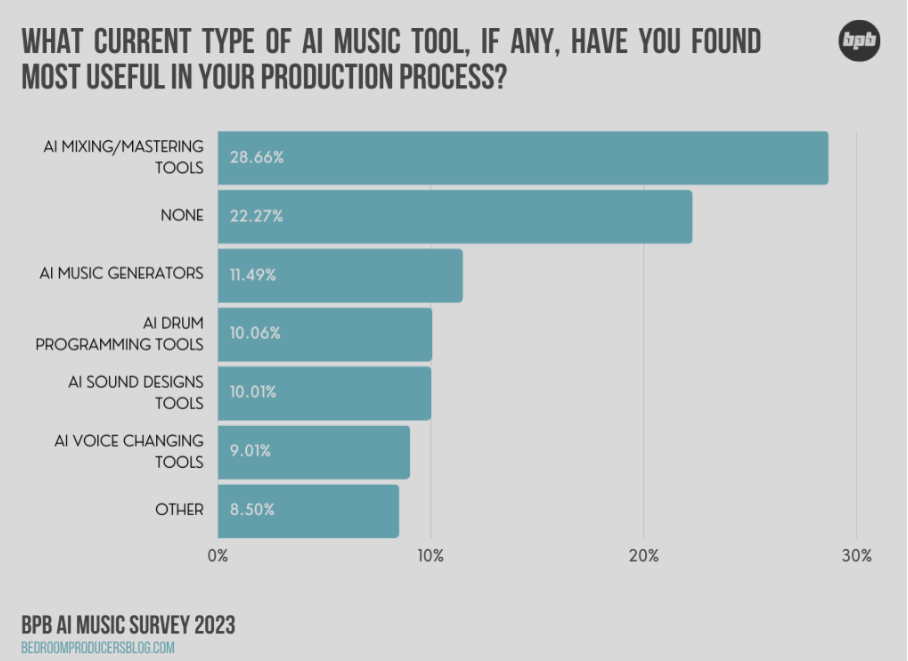Hey there, music maestro!
So, you want to dive into the captivating world of AI music generation? Can AI really turn a text prompt to music?
Whether you’re an aspiring composer or just a curious music enthusiast, I’m here to guide you on how to write those magical prompts with a flick of the pen (or rather, keyboard!).
Think of the best AI music generators as your musical collaborators, and your text prompts are like friendly conversations that spark their creativity. Just like interacting with a human musician, clear and expressive communication is key.
Remember, the more you write, the more you’ll uncover the immense potential of these musical algorithms.
Now go ahead and compose some fantastic text prompts. 🎶
Table Of Contents:
- The Emergence of AI-Generated Music
- How Text Prompt to Music AI Generators Work
- How to Write AI Music Prompts Effectively
- Best AI Music Prompts
- Google’s MusicLM Turns Text into Music
- MusicGen: Meta’s Response to Google
- It’s Seriously Impressive Tech
- The Legal Landscape of AI-Generated Music
- AI as Collaborator, Not Competitor
- The Future of Text Prompt to Music AI Models
- FAQs – Text Prompt to Music AI
- Conclusion
The Emergence of AI-Generated Music
We are now witnessing how artificial intelligence is transforming the music business. Technologies like Google’s MusicLM and Meta’s MusicGen are at the forefront of this revolution, turning text prompts into anything from melodic techno to soulful jazz tunes.
A major breakthrough came when a track featuring Drake and The Weeknd — entirely created by AI — went viral. This wasn’t just another song on your playlist; it was a game-changer for music creation.
Prompt to Song AI Generators: Changing The Way We Compose Melodies
Music generation has been revolutionized by the advent of AI models. The key to this transformation lies in text prompts or written instructions that guide an AI model in creating unique compositions.
A generative AI model, when given a text prompt, can generate high-fidelity music based on specific parameters outlined within it. These could include genre specifications such as melodic techno or soulful jazz, specific instruments to be used like a guitar solo or vocal quality desired, and even lyrics generation.
Text Conditioning for More Accurate Results
The power of these text prompts is further enhanced through “text conditioning.” This process involves training the generative AI on millions of audio clips paired with corresponding textual descriptions. As a result, when you turn text prompts into requests for your desired song or composition style, the system understands and generates music accordingly.
Implications for Sound Artists and the Music Industry
This revolutionary technology not only benefits sound artists but also brings about significant changes to the entire music industry. It allows musicians to experiment with new sounds without investing heavily in physical instruments or studio time.
Generating creative content from scratch? Recreating famous songs? Producing soulful jazz solos? Switching effortlessly to melodic techno beats? All these are now possible thanks to how effectively we can use text prompts within our advanced generative AIs today.
How Text Prompt to Music AI Generators Work
At its core, text-to-music AI leverages the power of deep learning and natural language processing to convert human language (text prompts) into musical compositions.
Here’s a glimpse of how the magic unfolds:
Data and Training: The AI needs to learn the patterns and relationships between text and music from vast amounts of data. Music datasets containing melodies, harmonies, rhythms, and other musical elements are combined with corresponding text prompts that describe the desired musical output.
Sequence-to-Sequence Models: The AI model typically uses sequence-to-sequence architecture. In this setup, the text prompt is the input sequence, and the music output is the target sequence. These models are also known as encoder-decoder models. The encoder encodes the text input into a numerical representation, while the decoder translates this representation into musical notes and structures.
Embeddings: To process text efficiently, the AI converts words in the text prompt into dense numerical vectors called embeddings. These embeddings represent the semantic meaning of words, allowing the model to understand the relationships between different words in the prompt.
Attention Mechanism: The attention mechanism is crucial for the model to focus on specific parts of the text while generating the music. It helps the AI pay more attention to relevant words or phrases, making the generated music more coherent and aligned with the text prompt.
Training and Fine-Tuning: During the training process, the AI model learns to associate the text prompts with the corresponding musical patterns in the training data. Fine-tuning is often used to improve the model’s performance and align it more closely with a specific musical style or genre.
Sampling and Creativity: When generating music from a text prompt, the AI uses a sampling technique to introduce some randomness into the process. This randomness adds creativity to the generated music, ensuring that each output is unique and not an exact replica of existing compositions.
Post-Processing and Rendering: After the AI generates the musical sequence, post-processing may occur to refine the output. This step can involve adjusting the dynamics, tempo, instrumentation, and other musical aspects to improve the final composition’s quality.
Feedback Loop: As users interact with the AI and provide feedback on the output, this iterative process enhances the AI’s ability to create more satisfying and personalized musical compositions over time.
And voilà! The result is a text prompt to music AI capable of composing original melodies, harmonies, and rhythms based on written text – a mesmerizing collaboration between human language and musical expression!
The possibilities are endless, and as technology advances, AI-generated music is destined to become an integral part of the musical landscape. 🎵
Source: Bedroom Producers Blog survey
How to Write AI Music Prompts Effectively
Can AI generate music from text prompts? What are the best prompts for AI-generated music?
The key to making beautiful music is to provide AI music generators with optimized instructions. Let’s break this process down into a few simple steps:
Be Specific: Start with a clear musical idea or theme you have in mind, such as an “upbeat jazz melody” or “dreamy ambient soundscape.” But don’t go overboard with specifics so the AI has some room for creativity.
Set the Mood: Describe the mood or emotion you want the music to convey. Emphasize feelings like “joyful and uplifting” or “mysterious and haunting.” This helps the AI understand the vibe you’re after.
Use Musical Terminology: You don’t need to be a music theory expert, but sprinkling in some musical terms can help. Mention things like “a groovy bassline,” “a syncopated rhythm,” or “a soaring violin solo.”
Reference Real Music: If you have a favorite song or artist whose style you want the AI to emulate, mention it! For instance, you could say, “Imagine a blend of Mozart and Daft Punk.”
Experiment with Length: The length of your prompt matters. Longer prompts give more context, but sometimes a short, punchy phrase like “funky disco beat” is all you need to get started.
Be Patient: Remember that AI music generators are still evolving. You might need to iterate and refine your prompts to get the results you desire. Don’t hesitate to experiment and try different approaches.
Have Fun and Be Curious: AI music generation is an adventure! Don’t be afraid to explore new genres, experiment with odd combinations, and embrace unexpected twists.
Respect the AI’s Artistry: While you’re guiding the AI, don’t be too controlling. Allow it to surprise you with its unique musical creations. Sometimes the best magic happens when you give the AI some creative freedom.
So there you have it – your ticket to unlocking the melodies of AI music generators.
Best AI Music Prompts
To help you get started with making AI music, here are some AI music prompts you can try, modify, and experiment with.
- “Generate an ambient electronic track with ethereal pads and soothing melodies that evoke a sense of floating in space.”
- “Create a jazz-inspired composition with a walking bassline, smooth saxophone improvisations, and brushes on the drums for a laid-back vibe.”
- “Design a cinematic orchestral piece for an epic battle scene, incorporating powerful brass fanfares and intense percussion rhythms.”
- “Compose a nostalgic and dreamy synth-pop song with lyrics reminiscing about long-lost memories and summer nights.”
- “Generate a fusion of traditional Indian sitar music and modern electronica, blending intricate ragas with electronic beats and synth textures.”
- “Create a dynamic and rhythmic African drum ensemble with authentic percussion instruments, capturing the spirit of a tribal celebration.”
- “Design an uplifting and motivational piano ballad with lyrics about resilience and overcoming obstacles in life.”
- “Generate a progressive rock instrumental with complex time signatures, intricate guitar solos, and shifting moods.”
- “Compose a lighthearted and cheerful ukulele track with whistling melodies, perfect for a carefree and sunny day.”
- “Create a dark and brooding industrial techno track with distorted synths and relentless basslines, reflecting a dystopian futuristic world.”
- “Generate an experimental ambient piece using found sounds and field recordings, exploring the concept of nature’s harmony.”
- “Compose a reggae-inspired track with a steady offbeat rhythm, lively guitar strumming, and lyrics celebrating unity and positivity.”
- “Design a Baroque-style harpsichord piece with ornamented melodies and contrapuntal interplay.”
- “Create a fantasy-themed symphonic metal track featuring powerful female vocals, epic orchestration, and driving guitar riffs.”
- “Generate a minimalist piano composition with repeating patterns and subtle variations, inspired by the works of Philip Glass.”
Remember, the best AI music prompts are tailored to your preferences and objectives, and they serve as a springboard for creativity, exploration, and artistic expression. By crafting well-defined text prompts, you can effectively collaborate with AI music systems to generate music that resonates with your vision and emotions.
Google’s MusicLM Turns Text into Music
In a groundbreaking move, Google has launched an innovative generative AI model that can turn text prompts into high-fidelity music: MusicLM. This revolutionary technology in the music industry is set to redefine how artists generate creative content.
This AI model, developed by Google Arts and Culture in collaboration with Universal Music Group, uses millions of audio clips from various genres such as melodic techno and soulful jazz.
The process begins when users input written prompts or lyrics generation requests. These text prompts are then processed by the generative AI, which creates unique compositions based on them.
The ability of this advanced tool to generate music based on specific instruments requested in the song description sets it apart from other models available today. Whether you’re looking for a guitar solo or vocal quality reminiscent of your favorite sound artist, this powerful tool delivers it all.
The system utilizes “text conditioning” where the written prompt influences not just lyrical content but also musical aspects like rhythm and melody.
It can cater to diverse genres including pop, rock, and country among others, making it versatile for any kind of musician or producer.
With access to over a million audio clips sourced globally via Universal Music Group’s vast library, its sophistication is unparalleled in terms of output diversity and richness.
This technological marvel promises endless possibilities for musicians worldwide while offering unprecedented opportunities for listeners who will get exposed to novel tunes generated through these text prompts.

MusicGen: Meta’s Response to Google
Music has always been a universal language that transcends borders. Now, technology is taking it to the next level with an innovative tool from Meta called MusicGen. This revolutionary music-generating tool uses generative AI to turn text prompts into high-fidelity audio recordings.
Powered by a dataset containing over 20,000 hours of music and trained on more than 10,000 hours of licensed songs along with almost half a million instrumental tracks, this AI model is set to change how we generate music.
It’s important to note that while these sources are not directly from giants in the music industry like Universal Music Group or popular artists such as Taylor Swift, they come from media libraries including Shutterstock and Pond5.
The functionality behind MusicGen lies within its ability to create short clips based on written prompts provided by users. For instance, you could ask for a “pop dance track with catchy melodies” or request a soulful jazz piece featuring specific instruments like guitar solos – the possibilities are endless!
The system can also be directed towards creating tunes reminiscent of certain eras or requested songs.
Beyond just generating snippets, longer compositions can also be created using this platform. Creators have the freedom to use initial outputs as reference points for further development, making it easier than ever before for sound artists and creative content creators alike!
This breakthrough in lyrics generation doesn’t just stop at melodic techno but extends across genres, offering unprecedented potential in transforming how we perceive and produce music today.
Key features of MusicGen:
- Text prompts: These are used as initial seeds for generating melodies and rhythms through algorithms.
- Text conditioning: You feed specific instructions to generate melodic techno beats, soulful jazz rhythms, guitar solos, etc., using textual inputs.
- Vocal quality: The quality output will depend on the vocal quality used in the input. By adjusting various settings during song creation (like pitch correction), users have complete control over their final product.
- Song request: You request a song style (e.g., “sad piano”) and get multiple unique compositions fitting the description.
- Instruments selection: Pick specific instruments like violin, guitar, piano, etc., for composition.
It’s Seriously Impressive Tech
Both MusicLM and MusicGen can turn text prompts into soulful jazz or melodic techno within seconds. It’s not just about lyrics generation; it involves an entire orchestration process that includes specific instruments, vocal quality, and even guitar solos.
The text prompt to music AI model is trained on over a million audio clips. A sound artist could input descriptive words like ‘slow’, ‘sad’, and ‘guitar solo’ and receive an entirely unique composition fitting those parameters—making it easy for artists to create music at scale.
In addition to providing requested songs with distinct musical elements such as rhythm patterns or chord progressions, this groundbreaking tech also allows for control over aspects like tempo and genre. Imagine being able to instantly generate music ranging from classical symphonies to modern pop hits!
But what makes this advancement truly remarkable is its potential applications beyond simple entertainment purposes. For instance, businesses can use these capabilities for personalized marketing campaigns featuring custom jingles created in real-time using customer data inputs.
In essence, this unprecedented technological breakthrough has brought us one step closer to making creative expression more accessible than ever before — it’s seriously impressive tech indeed!
The Legal Landscape of AI-Generated Music
The legal intricacies that surround AI-generated music can be a minefield.
To start with, imagine an AI model creating tunes similar to those by your favorite artist or record label — without their permission.
Sounds problematic?
You bet.
This was exactly what happened when Spotify was forced to pull songs generated by Boomy due to potential copyright issues. Here’s why Spotify made this move.
You might think these are rare instances. But wait till you hear about rapper Jay-Z’s run-in with his own digital doppelganger.
A YouTube channel used generative AIs trained on Jay-Z’s discography for covers that were uncannily accurate replicas of his style. The result? His record label Roc Nation filed copyright strikes against the channel citing unauthorized use.
This case took an unexpected turn though: after some time off air, these videos were reinstated in all their glory.
No kidding.
This surprising development led us right back to square one: how do we interpret existing laws regarding the fair use of derivative works in relation to new technologies like text prompt to music AI models?
If courts consider such uses as falling within “fair use”, then creatives using advanced tech tools like generative AIs may have greater freedom at hand. However, artists could also find themselves vulnerable to unsanctioned adaptations and modifications.
In response, artists might need to explore alternative licensing methods allowing certain types of reuse while still protecting rights at the same time.

AI as Collaborator, Not Competitor
As amazing as it all sounds, there lies a minefield of ethical considerations related to content ownership rights of AI music.
For instance, the use of training data incorporating copyrighted material into generated songs unknowingly can lead to violations, even if the original intent was purely artistic expression and not theft.
In their published paper discussing how they trained MusicGen, researchers highlighted ethical challenges posed by large-scale generative models, stating:
“Generative models can represent unfair competition for artists.”
They emphasized open research, ensuring equal access for all actors involved, thereby advocating transparency in tech advancements shaping our future musical landscape.
This highlights the need for clear guidelines regarding usage rights, ensuring creators aren’t inadvertently infringing copyrights during innovative pursuits.
The Future of Text Prompt to Music AI Models
AI-generated music opens up a world of exciting possibilities, but it also comes with its fair share of ethical concerns.
As this technology evolves, it’s crucial to address and mitigate potential ethical issues. Some of the main concerns include:
Intellectual Property and Copyright: AI-generated music blurs the lines of ownership and raises questions about who holds the copyright to the compositions. If an AI creates music that sounds similar to an existing artist’s work, it could lead to copyright disputes and legal challenges.
Plagiarism and Originality: With AI capable of generating vast amounts of music, there’s a risk of unintentional plagiarism. If AI-generated compositions closely resemble existing pieces or borrow too much from copyrighted material, it can raise ethical issues around artistic originality.
Unintended Bias and Stereotyping: AI models are trained on massive datasets that might contain biases present in society and historical music. As a result, AI-generated music may perpetuate stereotypes or reflect biased compositions from the training data.
Cultural Appropriation: AI music generators can create music inspired by different cultures, but if not done thoughtfully, it might lead to cultural appropriation, disrespecting the origin and significance of certain musical styles.
Artist and Composer Livelihoods: As AI-generated music becomes more prevalent, there’s a concern that it could impact the livelihoods of human musicians and composers. If AI music floods the market and reduces demand for original human compositions, artists may struggle to make a living.
Transparency and Attribution: AI-generated music might not always come with clear attribution, making it difficult for listeners to know if the music they’re enjoying is human-made or AI-generated.
Environmental Impact: Training AI models and running servers to generate music consume significant computational resources, contributing to the environmental impact of AI technology.
Misuse of AI-Generated Music: As with any technology, there’s potential for malicious use, such as creating AI-generated music for misinformation or propaganda purposes.
Addressing these ethical issues requires a multi-faceted approach involving collaboration between AI developers, musicians, policymakers, and society at large.

Here are some potential steps to mitigate these concerns:
Establishing Copyright and Ownership Rules: Clear guidelines and regulations are needed to address copyright and ownership concerns, defining who holds the rights to AI-generated music.
Diverse and Ethical Training Data: Developers must curate training datasets carefully, ensuring they are diverse, free from bias, and culturally respectful.
Transparency and Disclosure: Platforms that feature AI-generated music should clearly disclose its origins, informing listeners that the music is created by AI.
Support for Human Musicians: Emphasize the importance of human creativity and support artists and composers in their artistic endeavors.
User Education: Educate the public about AI-generated music, its limitations, and potential biases to foster a more informed and discerning audience.
By navigating these ethical challenges thoughtfully, we can harness the power of AI-generated music while preserving artistic integrity and respecting the contributions of human musicians and composers.
FAQs – Text Prompt to Music AI
What is the AI that makes music from prompts?
AI models like Google’s MusicLM and Meta’s MusicGen can generate music based on text prompts, creating tunes in a variety of genres.
Can AI generate music from text?
Absolutely. Advanced AI systems use textual cues to compose high-fidelity tracks, influencing everything from vocal quality to instrumental intensity.
How can AI be used in music?
AI can create original compositions, assist sound artists with lyrics generation, and even simulate the styles of renowned musicians. It’s reshaping the industry by offering new creative opportunities.
What is the impact of AI on music?
The advent of generative AIs has stirred legal and ethical debates around copyright issues while also opening up innovative avenues for creativity within the industry.
Conclusion
The arrival of text prompt to music AI models is truly a game-changer, reshaping the landscape of the music industry.
By using simple written prompts to generate high-fidelity music, this technology has unlocked new horizons in creativity.
However, legal and ethical issues are not to be overlooked. Copyright issues loom large as unlicensed usage threatens artist rights and stirs controversy.
Cases like Jay-Z versus YouTube underscore these complexities while highlighting potential paths for resolution.
Ethical considerations also arise with training data potentially incorporating copyrighted material into generated songs.
Organizations such as Universal Music Group are stepping up their efforts to regulate content in response to the rise of generative AIs.
This tech revolution impacts sound artists and lyricists too, challenging traditional roles but also offering fresh creative opportunities.
Looking ahead, we see a future where text prompt-based music generation could harmonize technology with artistry or fuel further contention within the industry.
Need help with writing music prompts? An AI prompt library can be a good starting point. Here you’ll find hundreds of pre-made prompts that you can use with AI music generators, AI art generators, and AI video generators. If you want to create a full music prompt from scratch, BrandWell’s generative AI chatbot AIMEE can help you do that. Sign up today!

